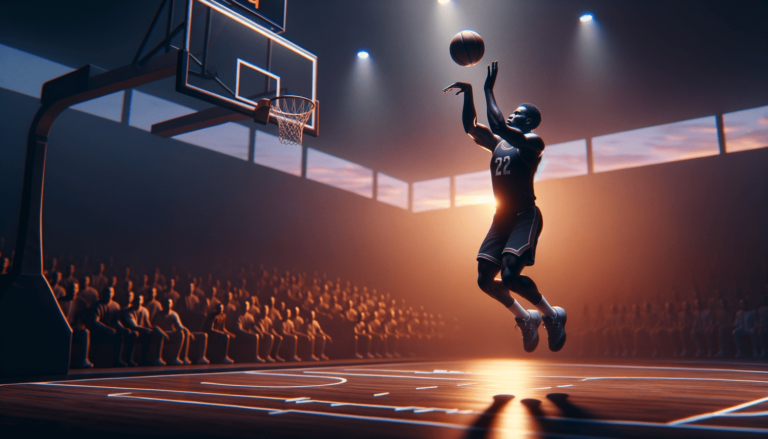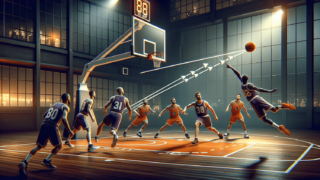
Are you ready to explore the exciting realm of one of basketball’s most game-changing shots? The three-point shot, often referred to as a “trey,” has transformed the sport over the years, levelling the playing field and allowing for thrilling comebacks. Whether it’s the exhilaration of an unexpected buzzer-beater or the high-pressure moments where one shot can redefine a player’s career, this integral aspect of basketball has provided fans with countless memorable occasions. So, fasten your seat belts as we go behind-the-arc for a deep dive into the world of the three-point shot and everything there is to know about it!
What Is a Three-Point Shot in Basketball?
A three-point shot in basketball refers to a shot taken from beyond the three-point arc, a designated area that encircles the basketball hoop at a specific distance. If a player successfully makes a field goal from this area, their team is awarded three points, as opposed to the standard two points for shots made within the arc.
A Journey Through The History of the Three-Point Shot
Behind every great invention, there’s a fascinating tale. The story of the three-point shot isn’t any different. By understanding its history, we can appreciate the impact of this game-changer in modern basketball.
The Birth of the Three-Point Shot
In 1961, the now-defunct American Basketball League (ABL) introduced the three-point shot, a concept pioneered by league founder Abe Saperstein. Although the ABL lasted only for a year and a half, it left an indelible mark by trailblazing the use of the three-point shot. In 1967, the American Basketball Association (ABA) adopted the idea as well, further popularizing its use. The three-point line would be put into NCAA college basketball games in 1980, and eventually, the National Basketball Association (NBA) made it a permanent fixture in the 1979-1980 season.
Evolution of the Three-Pointer Throughout the Years
In the beginning, professional basketball viewed the three-pointer as a risky, outlandish strategy. Over time, however, the three-point shot became critically important to basketball gameplay, with some teams even designing their whole offensive strategy around it. Gone are the days when players were reluctant to shoot from beyond the arc; now, players are well-trained to use this shot as a staple part of their arsenal.
Three-Point Line Distances – Regulations and Variations
Ever wondered what determines the distance between the basket and the three-point arc? Here’s an insight into how the arc’s distances have evolved across different levels of play.
FIBA
Initially, FIBA set the distance of its three-point line at 6.25 meters (about 20 feet and 6 inches). However, since 2010, the distance was increased to 6.75 meters (approximately 22 feet and 1.7 inches) from the center of the basket.
NCAA
When the NCAA first implemented the three-point line in 1980, the distance was set at 19 feet and 9 inches. For the 2008-2009 season, the distance increased to 20 feet and 9 inches. As of the 2019-2020 season, the three-point line distance for the Men’s Division I now stands at 22 feet and 1¾ inches. Interestingly, the Women’s Basketball remains at the 20 feet and 9 inches measurement.
NBA
Throughout the years, the NBA’s three-point line distance has seen several changes. The original distance established in 1979 was 23 feet and 9 inches, except for the corners, where the distance was 22 feet. In the 1994-1995 season, the NBA shortened the distance to a uniform 22 feet to increase scoring. However, this change was reversed in the 1997-1998 season, reverting to the original distance in place since 1979.
The Golden Era of Three-Point Shooting
Basketball has, over time, seen an undeniably increasing reliance on the three-point shot. Players have honed their skills, and coaches have adopted strategies to improve proficiency from beyond the arc. Let us delve into the factors instrumental in solidifying the three-point shot’s key role in basketball today.
Strategic Craftsmanship and Analytics
Over the past couple of decades, basketball advanced analytics provided insights into maximizing scoring efficiency by focusing on shot selection. These analytics revealed that scoring more points per shot attempt is a fundamental aspect of winning games. The three-pointer suddenly looked a lot more attractive, giving birth to new game strategies that revolved around the three-point shot. As a result, the three-pointer plays a central role in modern basketball gameplay
The Splash Brothers Take Center Stage
Stephen Curry and Klay Thompson, famously known as the “Splash Brothers,” have played a significant part in popularizing the three-point shot in contemporary basketball. Their incredible shooting prowess and performances for the Golden State Warriors have mesmerized the world, making the three-pointer a hallmark of the current basketball landscape.
Record-Breaking Three-Pointer Milestones
The NBA has seen many players leave their mark with unforgettable three-point performances. Let’s take a look at some of the record-holders throughout the years:
- Ray Allen – all-time NBA leader in three-pointers, with 2,973 made treys
- Stephen Curry – fastest player to reach 2,500 three-pointers and the first player to hit 400 treys in a single season
- Klay Thompson – NBA record for most three-pointers in a single game, with 14
Essential Skills for a Successful Three-Point Shooter
Want to become a sharpshooter from beyond the arc? Developing the right set of skills is crucial for mastering the three-point shot. Here are some techniques to work on:
Correct Shooting Form
The path to becoming a successful three-point shooter begins with learning the correct shooting form. One essential element is the ‘BEEF’ acronym, which stands for Balance, Eyes, Elbow, and Follow-through. Implementing BEEF and other shooting techniques can improve your shot consistency and precision from the three-point range.
Proper Footwork
A solid foundation is a key to achieving accuracy and consistency in shooting. A shooter’s footwork should emphasize balance, quickness, and being in the proper position to take the shot. This vital skill plays a significant role in making or breaking a player’s shooting success.
Strength and Conditioning
To be an effective perimeter shooter, you must have strong core muscles and good endurance levels. Strength and conditioning workouts targeting core muscles and lower extremities will facilitate better shooting results from beyond the arc. Building upper body strength and working on your stamina will also contribute to overall shooting performance.
Practice and Repetition
Like with any skill in basketball, practice makes perfect when mastering the three-point shot. The more you practice shooting from the three-point range, the better you will become. By progressively working on your technique, form, and power, you will increase your accuracy and efficiency from the three-point line.
The Future of the Three-Point Shot
In the ever-evolving landscape of basketball, the three-point shot currently holds a critical standing. Will it maintain its significance moving forward? Here’s a glimpse into what the future may hold for the iconic shot.
Continued Dominance
As long as teams place strong emphasis on analytics and continue crafting their game strategies around the three-pointer, it’s likely that the shot will remain a potent weapon on the court. The current generation of players is growing up practicing and perfecting long-range shooting, which indicates that the three-point shot’s dominance will persist.
The Rise of the Four-Point Line?
As innovative thinking continues to change the face of the game, we may see even more groundbreaking ideas enter the world of basketball. The introduction of a four-point line – rewarding shots made from an even greater distance – is not completely out of the realm of possibility. For now, it remains an exciting prospect to consider for the future.
Remember, basketball is a continually evolving game, and we can never predict what the future may hold. As fans and players alike, we must keep our minds open to innovations that could potentially reshape the sport. Until then, the three-point shot is here to stay as an integral and fascinating part of the beautiful game we all love.
The Rules and Regulations of the Three-Point Shot
In addition to the aforementioned historical background and different distances, a deeper dive into the rules, regulations, and some peculiarities surrounding the three-point shot will help enrich your understanding of this crucial element in the game of basketball.
Setting Your Feet Behind the Line
For a shot to count as a three-pointer, a player’s feet must be fully behind the three-point line when they initiate their jump or shooting motion. If either foot is touching or crossing the line, the shot is considered a two-pointer. This makes foot placement during the shooting process a vital skill for players trying to maximize their scoring power.
Goal Tending and Interference with Three-Point Shots
While goal-tending rules apply to any shot attempt in basketball, three-point shots have some unique aspects. Since three-pointers tend to have a higher trajectory, there are fewer instances of goal-tending on such shots. However, they are not exempt from the rules governing basket interference. If a defensive player reaches through the plane of the net and touches the ball or interferes with the rim during a three-point shot attempt, a basket interference violation is called, and the shooting team is automatically awarded three points.
Fouled While Shooting a Three-Pointer
If a player is fouled while attempting a three-point shot and the shot is unsuccessful, they are awarded three free throws opportunity. However, if they manage to make the basket despite being fouled, the shooter is rewarded with an additional free throw attempt, known as an “and-one.” The possibility of a 4-point play can dramatically shift the momentum of a game, making it one of the most electrifying moments in basketball.
Memorable Three-Point Shooting Performances
Great three-point shooting performances have been pivotal in shaping basketball history. Let’s revisit some of the most iconic moments where the three-pointer took center stage.
Reggie Miller’s 1995 Playoff Comeback
Reggie Miller is a name synonymous with three-point shooting. In Game 1 of the 1995 Eastern Conference Semifinals, Miller showcased his exceptional skills by scoring eight points, including two three-pointers, in just 8.9 seconds. This moment will forever be etched in NBA history as one of the most stunning comebacks powered by the three-point shot.
Ray Allen’s Clutch Shot in the 2013 NBA Finals
During Game 6 of the 2013 NBA Finals, with less than six seconds left on the clock and the Miami Heat trailing the San Antonio Spurs by three points, Ray Allen hit a corner three-pointer to tie the game. The shot took the game to overtime, and the Heat eventually won the championship in Game 7. Ray Allen’s clutch three-pointer remains an unforgettable moment in basketball history.
Stephen Curry’s Game-Winner Against the Oklahoma City Thunder (2016)
One of the most memorable three-pointers in recent history is Stephen Curry’s game-winning shot against the Oklahoma City Thunder in 2016. With the game tied in overtime and seconds to spare, Curry pulled up near the half-court line and drained a 37-foot three-pointer to secure the victory, setting the tone for the Golden State Warriors’ record-setting 73-win season.
Revolutionary Three-Point Shooters Worth Mentioning
Beyond the “Splash Brothers” and the record-breakers previously mentioned, various other sharpshooters throughout basketball history have left a substantial impact on the game with their three-point shooting prowess. Here are a few noteworthy names:
- Larry Bird – A basketball legend whose clutch performances and exceptional shooting ability helped popularize the three-point shot in the 1980s.
- Reggie Miller – One of the most feared shooters in NBA history, renowned for his clutch shooting and ability to score quickly from beyond the arc.
- Steve Kerr – A former NBA player and current head coach of the Golden State Warriors, Kerr boasts a phenomenal 45.4% career three-point shooting percentage.
- Peja Stojaković – The Serbian sharpshooter was renowned for his exceptional shooting touch and effortless ability to make tough shots from the three-point line.
With this comprehensive insight into the world of the three-point shot, you are now primed to appreciate its significance and impact on modern basketball more deeply. As the game continues to evolve, stay attuned to the changes and marvel at the moments where the three-pointer alters the course
Frequently Asked Questions
If you still have lingering questions or need some quick answers about three-point shots, look no further! Here’s a handy FAQ section addressing some of the most common queries related to the captivating topic of three-point shooting in basketball.
1. Why was the three-point shot invented?
The three-point shot was invented as a way to add excitement to the game of basketball and incentivize players to attempt more challenging and skillful long-range shots, eventually leading to a more dynamic and strategically varied gameplay.
2. Has the NBA always used the three-point shot?
No, the NBA did not initially use the three-point shot. It was first introduced in the now-defunct American Basketball League in 1961, eventually making its way into the NBA in the 1979-1980 season.
3. Are three-point shots more difficult than two-point shots?
Yes, three-point shots are generally considered more difficult than two-point shots due to the increased distance from the basket. However, proficiency in three-point shooting can be developed with practice and proper technique.
4. How are three-point shooters trained?
Three-point shooters are trained through a combination of skill development, strength and conditioning, and practice. Key aspects include learning the correct shooting form, mastering footwork, building core strength, and refining shooting technique through repetition.
5. What is the distance of the three-point line in college and NBA basketball games?
In NCAA Men’s Division I basketball, the three-point line distance is 22 feet and 1¾ inches. In Women’s Basketball, it is 20 feet and 9 inches. In the NBA, the distance is 23 feet and 9 inches, except in the corners, where it is 22 feet.
6. Has the three-point shot always been popular in basketball?
No, the three-point shot was initially seen as a gimmick and risky strategy. However, its popularity has grown over time as players, coaches, and strategists have recognized its value in shaping the game and maximizing scoring opportunities.
7. Is the three-point shot more valuable than a two-point shot in some cases?
Yes, since a successful three-point shot awards the team three points, it can be more valuable than a traditional two-point shot, especially in situations where a team needs to catch up quickly or maximize their scoring efficiency.
8. Can a player be fouled while shooting a three-pointer?
Yes, a player can be fouled while shooting a three-pointer. If the shot is unsuccessful, the player is awarded three free throws. If the shot is successful, they receive one additional free throw attempt, creating a potential four-point play.
9. How did Stephen Curry and Klay Thompson impact the popularity of the three-point shot?
Stephen Curry and Klay Thompson, also known as the “Splash Brothers,” have contributed significantly to the popularity of the three-point shot with their extraordinary shooting skills, record-breaking performances, and dribble-and-shoot playstyle that became a hallmark of the Golden State Warriors’ success.
10. Who are some all-time great three-point shooters?
Some all-time great three-point shooters include Ray Allen, Reggie Miller, Stephen Curry, Klay Thompson, Larry Bird, and Steve Kerr, among others.
11. Is it possible for three-pointers to be goal-tended or interfered with?
Yes, three-pointers can be goal-tended or interfered with, just like any other shot attempt in basketball, although it is less common due to their high trajectory. Basket interference on a three-point shot awards the shooting team three points.
12. Do other basketball organizations have a three-point shot like the NBA?
Yes, other basketball organizations, such as FIBA and the NCAA, also have a three-point shot, with varying distances for their three-point lines.
13. Could a four-point line be introduced in basketball in the future?
While it remains speculative, the introduction of a four-point line as a further innovation in basketball is not an entirely improbable concept. It would reward even more challenging long-range shots and further diversify game strategies.
Featured Posts
- No pillar pages found.





